#some cataloguers like literate data collection
Explore tagged Tumblr posts
Text

#metanarrative#lits auth#some cataloguers like literate data collection#people lie#get a critical theory#razors rock#𐛴
0 notes
Text
honeys it girl magazine october edition!!⋆.ೃ࿔*:・🎀

welcome back to honeys it girl magazine, this is the october catalog. get ready for the inside scoop on data that i've collected, things i've learned/started doing, and just general info like that organized in kind of a teen-magazine inspired fashion. a magazine for it girls ✨ and now please enjoy, the it girl magazine.



HOW TO HAVE THE MOST DOLLY SLUMBER PARTY EVER ;
when i think of the month of october i think of GLAMOROUS parties. and that incorporates girly slumber parties, halloween parties, a LOT of parties. SOO the kind of party that i wanted to focus on in this month's catalogue is slumber parties.
to throw a successful slumber party we first need a plan. make sure that u have refreshments, entertainment, invitations and all of that planned. if u wanna have a SUPER cute slumber party have a theme. some theme ideas can be
♡ victoria's secret (V.S. pj's, lingerie, everyone wears a V.S. robe etc)♡ 2000's ♡ movie based pajamas♡ a color scheme (black and pink is my fave)
and we can't have our girls being bored at our slumber party can we? make sure that u plan fun activities like having a fashion show (playing dress up) playing dress to impress or video games like that, baking sweet treats, karaoke, dolling each other up ETC. for refreshments you could do a snack bar or make mocktails, you could even do a milkshake station!
THE VICTORIA'S SECRET FASHION SHOW 2024 ANALYSIS ;
🧁 anok yai’s floral number (she’s literally blooming, she looks like a FLOWER. her hair is giving barbie dolll and ultimately she had my favorite look of the whole entire night. the WINGSSS, the shoes everything just goes together beautifully.)
🧁 gigi hadid (she looks like a lavender princess fairy and it looks amazing on her. but PLEASEE why the slick hair?? when i think victorias secret im thinking of bouncy voluminous hair. i LOVE her wings though. they're so big and over the top and i love it)



🧁 imaan hamman (also goes with lisa and anok yai in my top three favorite looks of the night. its so simple but in my opinion her look gives the victorias secret that we all know and love the most.)
🧁 alex consani (i rly rly love baby blue on her, again, please bring back bouncy voluminous hair. and i kinda wish they gave her fluffier wings.)
🧁 lisa’s black lacy number (def one of my favorites on the whole runway. i wish she had black lacy wings instead of the structured ones but easily one of my favorites)
🧁 maty fall (the silk, the feathers, chefs KISS. in his case i think the minimal wings look the prettiest because her outfit is fuller, the delicate wings complement it beautifully.)
OCTOBER BODYCARE, MAKEUP AND FRAGRANCE FAVORITES ;
body care : hello kitty strawberry oat milk body balm from creme, vanilla creme brûlée body lotion from hempz (this one smells like HEAVEN), and fresh cream by philosophy. i rly loved the nyx marshmallow primer and for fragrance the soft and dreamy scent from victorias secret PINK (it just gives me so much nostalgia around this season 💗🍬)
DRESS TO IMPRESS NEW UPDATE ;
dress to impress is every hottie's favorite game, and when DTI dropped its halloween update, everyone including myself was so super STOKED about it. there are new codes and SO many new possibilities unlocked. speaking of codes…💬🎀


❤︎ CH00P1E_1S_B4CK (boots, jacket and skirt)
❤︎ UMOYAE (skater dress)
❤︎ D1ORST4R (star purse and hair bow)
❤︎ S3M_0W3N_Y4Y (axe weapon)
OCTOBER IT GIRL ACTIVITIES ;
like i said in the first section of this month's magazine, i associate october with PARTIES and ik a lot of us are going to halloween parties so i just wanted to share some rules of thumb especially if its ur first party, on how to have fun while also being safe.
make sure that u have a designated driver at all times
don't overdo it with the drinks, thats never hot
make sure u have ice cold water to sip on, on the car ride home



be careful, make sure that drinks are poured in front of u or you get them yourself
dont party by yourself GO WITH A FRIEND U TRUST AND STICK TOGETHER
and of course have fun 🍭 this year im dressing up as the white rabbit from alice in wonderland so im super excited to look cute and have fun with my friends
if partying is not ur thing there are SO many fun things that you can do this october. for example binge watching october movies, or doing fall related activities like we talked about in last month's section. some movies that i love to watch in october are
♡ jennifer's body
♡ ginger snaps
♡ scream
♡ the love witch
i dont usually watch things that are too scary which is why my list is so short 😭 i get scared rly easily so i try and watch movies that aren't SO scary but if you like that there are some rly good ones out there.
WHATS MY HOROSCOPE? (OCTOBER 27-31)
♡ for virgo, the libra solar eclipse on october 2 brings an unexpected opportunity to your financial realm and a boost of confidence as it allows you to showcase your talents. a surprising gift of abundance arrives! jupiter stations retrograde in gemini on the ninth, prompting you to review your long-term goals over the next five months.
♡ for aries, on october 2, the libra solar eclipse brings change to your relationships. unstable connections will be tested while authentic bonds will be strengthened. look for opportunities in love. jupiter stations retrograde on the ninth, traveling backward through the sign of gemini and your communication sector. between now and february 2025, you’re invited to explore the ways in which you connect with others. explore a variety of ways to express your mind. jupiter loves to facilitate growth, even when retrograde, making this a profound time to learn quickly.



♡ for taurus, the libra solar eclipse on october 2 awakens your mind, body, and soul! touching down in your sector of self-care, the eclipse offers the opportunity to embrace a new cycle of health and wellness. your skills will receive a boost. jupiter stations retrograde on the ninth in your zone of money and resources, challenging you to explore a new approach to the material world over the next five months.
♡ for gemini, on october 2, the libra solar eclipse brings change to your romantic life. an empowering new cycle begins that encourages you to embrace pleasure and distance yourself from people or situations that no longer bring authentic joy. this is a time to prioritize what truly makes you happy. jupiter stations retrograde in your sign on the ninth, urging you to reinvent yourself over the next five months.
♡ for cancer, the libra solar eclipse on october 2 lands in your zone of intuition and brings a new cycle of emotional strength. this eclipse could bring unexpected changes to your environment, so be sure to honor your comfort and security. jupiter stations retrograde in gemini and your zone of rest on the ninth, inviting you to relax over the next five months.
♡ for leo, on october 2, the libra solar eclipse activates your communication zone, setting off a new cycle of connection. unexpected information emerges that inspires you to action. jupiter stations retrograde in your friendship sector on the ninth. over the next five months, consider ways you can strengthen your bonds with others.
♡ for libra, on october 2, a powerful eclipse in your sign brings surprising new beginnings! personal revelations provide fresh excitement for the future. as you walk a new path, remember how powerful you are. jupiter stations retrograde in gemini on the ninth, encouraging you to learn through experience over the next five months.
♡ for scorpio, on october 2, the libra solar eclipse touches down in your zone of rest, encouraging surrender and relaxation. through soul-searching, this eclipse could bring forth a much-needed spiritual awakening. the energy is also creative and imaginative. jupiter stations retrograde in gemini on the ninth, encouraging you to embrace transformation over the next five months.
♡ for sagittarius, on october 2, the libra solar eclipse activates your zone of friendship and hope, inspiring faith for the future. expect surprising information in your social circles! an exciting new collaboration could be in the works. jupiter stations retrograde in gemini and your relationship realm on the ninth, encouraging you to explore your role in your closest connections over the next five months.



♡ for capricorn, on october 2, the libra solar eclipse awakens your career zone, encouraging you to step into your power! an unexpected opportunity to showcase your gifts emerges, and important people are noticing your strengths. surprises related to your career could open new pathways to success. jupiter stations retrograde in gemini on the ninth, prompting you to explore new self-care practices over the next five months.
♡ for aquarius, on october 2, the libra solar eclipse activates your sector of adventure, eliciting excitement! you could be taking an unexpected trip or seizing an opportunity to broaden your horizons. knowledge is power, and this eclipse could provide surprising information that helps you expand. jupiter stations retrograde in gemini on the ninth, encouraging you to explore your creative side over the next five months.
♡ for pisces, the libra solar eclipse on october 2 brings major transformation in your realm of money and intimacy! unexpected changes open new doors of opportunity, and while this is exciting, it requires you to face your shadow and abandon fear. a surprising, magical moment of abundance emerges. jupiter stations retrograde in gemini on the ninth, inviting you to rest and embrace comfort over the next five months.
#honeysitgirlmagazine✨💝#honeytonedhottie⭐️#it girl#becoming that girl#self concept#self care#that girl#self love#it girl energy#dream girl tips#dream girl#dream life#dreamy#hyper femininity#hyper feminine#girly#girl blog#it girl magazine#it girl lifestyle#it girl journey#princess#dolly#fashion#passion 4 fashion#girly magazine#horoscope#monthly catalogue#victorias secret#victorias secret fashion show 2024#beauty secrets
534 notes
·
View notes
Text
There's a lot this article touches on, but the parts about fossil preparation are kind of in poor taste. I'll go over some of it under the cut.
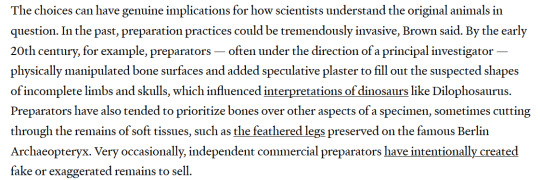
There's a reason we usually don't publish on things we prepare. They say it right here - we can literally, whether purposeful or accidental, modify fossils as we see fit. We could imitate pathologies or create marks with air scribes or picks that are misinterpreted as pathologies, remove or obscure parts of a fossil that may be diagnostic, etc. (Of course we don't endear to do these things, they're just possible).
Whether through inexperience or poor dexterity some budding preparators can cause damage that only someone with a trained eye could notice. Preparators aren't always required to be trained in the sciences or have thorough anatomical knowledge, and thus can reconstruct things wrong, without scientific guidance. Like filling holes where there's supposed to be… holes! Like a fenestrum or foramen, for example. This is why we have references, but more importantly, we do the minimum unless instructed to do otherwise by a supervisor or exhibits team - one of a few scenarios where a curator can rightfully step in.

This is why we're trained to preserve almost any bone we see. Often there are small isolated bone chunks hovering in matrix that are thrown in a box with the specimen. A lot of pieces can't be reattached because they're too weathered or of indeterminate origins (“IBF’s” for short).
"Creating" something "artistic" is another way of implying we're making it up as we go.

If someone hands me a fossil and tells me to look at this "multimedia sculpture", I'd be confused. It's a fossil, not an art project.
Academic fossil preparation is fundamentally a scientific endeavor that also requires artistic abilities, but not creativity. We use various methods that are tried and true (and sometimes experiment with new ones) to expose an element from matrix.
The act of preparing a fossil is not providing new data. The fossil itself is the data. We just make it available. That being said, if we provide measurements, take and analyze samples of the matrix for various analyses, then that's providing valuable data. Would that warrant an authorship? Maybe.
This raises another question though. If anyone who worked on a fossil gets an authorship, then can authorship compound?
The person who found the fossil but didn't do anything with it afterwards - just dug it up and sent it to the lab, for example. Do they get to be an author? On our field crews we have up to 30 people over the whole season. 30 coauthors and 99% of them are not scientists.
The collections manager who just painted a number on it, catalogued it, and put it away?
How about the curator who allowed a researcher access to the collection who didn't collect any data but just answered some emails and opened the drawer for it to be studied?
The land owner who gave you permission to dig?
Finally, the preparator who just exposed it from the rock. They do more science inherently than the others, but if no parts of the scientific method were conducted and no data was produced (save for the fossil simply being brought back into the world), do they get an authorship?
tl;dr We don't need authorships for the act of preparing fossils unless we provide data and go through the scientific process (like what's usually required for any authorship). Many parts of the process is not science. Just acknowledge our work in your paper and we'll be more than happy.
#fossil preparator#fossil preparation#science#paleontology#palaeontology#paleoblr#palaeoblr#fossil prep#fossils#dinosaurs#fossil
199 notes
·
View notes
Note
How does Barnes & Noble allocate shelf space and choose books to put on display? Do publishers pay to have their books in Barnes & Noble stores? Do they pay to have their books displayed in prominent spots? What about independent bookstores? How do bookstores and libraries find out about upcoming books to order? Thanks!
Oy. This could be the topic of like, a nonfiction book (for a very niche audience), or a college seminar, rather than a TUMBLR POST, but hey.
First, a caveat: Please do bear in mind that, while I have 35 years of bookstore experience, I don't work for B&N or have any insider access to B&N; all my knowledge about B&N comes from easily available, non-paywalled reportage that can be found by anyone online. I have never worked for a library except as a board member, so I have zero insider library collections knowledge. I also was a bookstore buyer a decade ago at this point, so some things might have changed -- and I worked for an independent bookstore (key word is INDEPENDENT -- ie, different indies may have totally different ways of doing things!) -- So this is quite broad strokes info.
I'm going to take your questions out of order because it will make more sense.
How do bookstores and libraries find out about upcoming books to order?
The first and most obvious way bookstores and libraries find out about upcoming books to order is via the Publisher's Frontlist Catalogue. "Frontlist" is the term for BRAND NEW / FORTHCOMING BOOKS. Catalogue is exactly what it sounds like -- literally a big ol' catalogue that describes the books, has early reviews and blurbs and whatnot, is full of praise for the books, yadda yadda. Catalogues are divided into multiple "seasons" throughout the year. (Nowadays, catalogues are mostly digital via Edelweiss -- but the same concept applies!)
Generally speaking, publishers have Regional Sales Reps across the country. Those reps physically go to the bookstores in their region every season and present the future season's frontlist offerings (ie, the stuff in the catalogue!) to the buyer. (Very small or far-away stores might have a phone rep -- and nowadays some rep meetings are done via Zoom -- but you get the idea!) The reps have marketing material like ARCs or samples of the books to share, and be able to give more intel than the catalogue alone can do.
It's the sales rep's job to know the bookstore buyer well, know the audience who shops there, and make great recommendations to the buyer. The buyer makes decisions about what to stock based in part on the sales rep's recommendation, but also on whether or not they liked the book or think that their patrons will like it, and based on historical data, like how that author or genre usually does in their store, etc etc.
Sales reps visit about 6 months prior to the season being discussed -- so the Fall 2024 books that are in stock at stores now and in time for Christmas were certainly already ordered before Easter.
Independent Bookstores have their own sales reps; B&N and Target and Amazon and places like that have their own sales reps just for them. (I don't really know how it works for libraries -- very big library systems might also have their own sales reps, but I don't think very small systems would, but idk!)
Other ways they find out about books to order: Booksellers and librarians (and publishers) attend library conferences and trade shows every year, sometimes multiple per year both regional and national; the publisher's sales and marketing teams do presentations about books, have booths with all their upcoming books on display, etc etc.
Booksellers and librarians also are regular people in society, so sometimes they find out about new books sometimes the same way anyone does - through the media and social media! They read reviews, listen to the radio, watch Colbert, go on Instagram, or whatever -- so if they skipped it or only bought two copies when they saw it in the catalogue months and months ago, but then there's a huge media blitz about it, or some amazing reviews come through, the publisher will probably send them a note like "heyyyy just so you know, this is getting HUGE BUZZ, you should probably order extra!"
Basically: Publishers Sales, Marketing and Publicity departments are all doing things behind the scenes for months before a book ever hits a bookstore shelf. That's how books get on the shelf.
How does Barnes & Noble allocate shelf space and choose books to put on display? (What about indie bookstores?)
B&N now chooses books to be on display at the store level. (More on that in the next question). So I'll answer the Indie Bookstore part, and we can assume that a very similar calculus is going on at individual B&N locations!
As explained above, buyers order most of the frontlist books for any bookstore from their sales rep many months before they come out. For a chain bookstore like B&N or a very large independent with multiple locations, that frontlist buyer may be located in some central location -- for smaller stores, buyers are on-site at the bookstore. (A store might also have a "backlist" or "restock" buyer, either the same person or, for a bigger store, a totally different person, who places smaller orders from wholesalers during the week to fill special orders for books customers request and to replenish stock of books they are selling well).
On the backend, bookstores use "turn" to allocate how much shelf space a given section will have -- but that's a much more technical / granular answer that you can read more about here. But as for what comes in and what gets displayed, the new books get into the store in the first place because the buyers have ordered them months in advance, usually via the sales rep (as described above), and when they come in, booksellers use their brains and taste to display them.
Most bookstores have several tables or displays that are always the same (with rotating stock) -- something like New and Noteworthy in every section. So New Hardcover Fiction, New Paperback Fiction, New SF/F, New Nonfiction, etc. When large piles of new books come in every tuesday, the booksellers on the floor will put the piles of books on the New table appropriate for that book. If a pile is getting low, they will swap those ones out so that they table looks full. You get the picture!
Most bookstores also have temporary displays -- seasonal, for a holiday, or themed in some way. For example, it's late October as I type this, and my local bookstore currently has a Kids Halloween display, an adult "Spooky Season" display, a display about democracy/voting (because election day is around the corner), a display about autumn/cozy vibes, a display about fiber arts (because the town hosts a massive craft show), etc. The manager or the owner or one of the booksellers might decide "oh, isn't it funny that all these books have OWLS on them this season, let's make an OWL display" -- and they put whatever they want on it.
(Again, for B&N, many decisions probably also are made at Headquarters -- BUT, individual stores have leeway about how they display their books based on their location, etc etc.)
Do publishers pay to have their books in Barnes & Noble stores? Do they pay to have their books displayed in prominent spots? What about independent bookstores?
Yes and no? Kindaaa, but not really in the way you are thinking?
ETA: THIS IS INSANELY COMPLICATED AND THE EXPLAINER BELOW IS JUST BARELY SCRATCHING THE SURFACE. It's just the best I can do, in this forum, right now.
OK. There's something called "Co-Op" -- that stands for like, "co-operative marketing" or something like that. There's a world in which you could consider Co-Op "publishers paying to have books in stores" -- that's how it kind of was historically, anyway.
Basically, IN THE PAST (I really can't stress that enough), publishers and major bookstores like B&N would come to some sort of agreement about certain titles that would "get co-op" -- like, OK, we have a Spooky Season table in the front of the store, it will cost you X-hundreds/thousands (??) of dollars to have a pile of your new upcoming book SPOOKY GHOST STORY on the front table of every B&N store. Publishers paid it, the bookstore ordered all those books and put them on display. Here's an article about that from 2010 that gives the basics and some links.
This straight-up "paying for a display slot" MIGHT still be the case at stores like Target, I have no idea. But for B&N, it's not the case anymore. This article from 2022 explains how the revamp of B&N includes getting rid of "pay to play" displays:
"Although the chain’s stores carry similar titles, in a shift away from centralized buying, individual managers determine where the books are placed and order quantities. The focus better aligns assortments with local tastes. Mr. Daunt told Publishers Weekly last year his goal is to provide managers with tools and then “get out of the way.”
Co-op title placement practices have also been ended because unpopular titles were receiving prominent placement and driving excessive return rates."
FWIW, Indie bookstores didn't / don't usually do "co-op" in quite the same way -- a single independent bookstore simply doesn't have the money or clout for it to be worth it for a publisher to pay them for title placement. Like, if Grandma Sassy's Olde Bookery orders five copies of a new book, that's huge for them, the publisher doesn't care what Grandma does with her displays, it's not making a dent for Penguin Random House, you know? Much different deal than a chain.
HOWEVER, co-op isn't ONLY about "pay to play" title placement. For example, let's say the publisher has a huge new book they want to promote because it is hotly anticipated and they have nine bajillion copies. They might create a special display out of cardboard (called a "dump") that fits 15 copies of the book -- any bookstore who orders 15+ copies of the book gets this special cool display, and a special discount.
OR, maybe the publisher decides to do a "Summer Reading Special" where they create special paperbacks of 20 different titles that have "buy two get one free" stickers on them -- if a bookstore wants to participate, they will order however-many copies of those books, but they will get a much better discount, both as an incentive to participate and put these titles on display and push them, and to make up for the money they would be losing by giving some of them away.
OR, a bookstore is doing a special event for an author, and they pay for a bunch of special posters to be made -- they might be able to get reimbursed from the publisher for some or all of the money they spent.
Those things are (kinda) the publisher "paying" the bookstore, so they are also technically co-op marketing! But as you can see, it's not quite the same as publishers directly paying a bookstore for a certain title's placement.
Sorry for the length, but hey -- that was a lot of questions!
8 notes
·
View notes
Text
Big the Cat Isn’t Real in Frontiers
In regards to Sonic Frontiers, something has been eating away at me since I completed the game, and I couldn’t find anyone else talking about it, so here I go! I understand that there have been comics released surrounding Sonic Frontiers, but I have yet to look into them, my analysis here is from the game itself, the animated prologue, and technically the Twitter Takeover, though they don’t mention Big at all from there. Sonic Frontiers Spoilers.

I legitimately believe that the Big the Cat that appears in Frontiers is not real. When Sonic first meets Big, he’s already in cyber space. Upon this encounter, I thought his random appearance was a reference to Adventure 2, in which he’d randomly appear in strange areas. Still, Knuckles, Amy, Tails and Eggman are all trapped in cyber space throughout the game, so surely Big must also be trapped as well, correct?


Sonic: “Big!? What are you doing here? HOW did you get here? What even IS here?” Big: “I dunno. I was looking for fishing spots and wound up here.”
Seems like a simple enough explanation at first. In character, at least. On top of that, much like everyone else (excluding Eggman), he has his own “memory tokens,” which in this case translated to Purple Coins, solidifying he was definitely, probably, trapped in cyber space.

Yet, by the end of the game, I couldn’t help but notice that Big was not with the cast of characters leaving the island.

In fact, we never saw him get sucked into cyber space in the first place. There’s proof that everyone else was seen in the PROCESS of being trapped, except for Big. Eggman went into a forest, did a thing and it immediately backfired before the game had a chance to begin, Tails, Amy and Sonic were all on the Tornado when they got trapped, and Knuckles got his own animated prologue justifying his reason for being here.


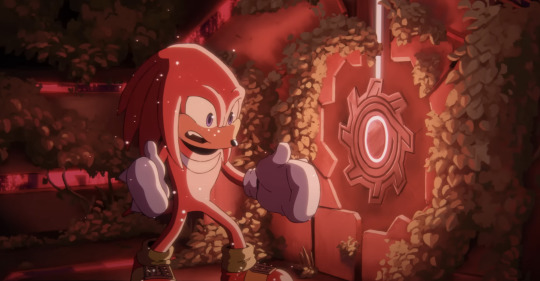
Big, on the other hand, did not. All we get is a line of dialogue claiming he did.
It also became known to us that cyber space is a collection of data pulled from the users’ memories.
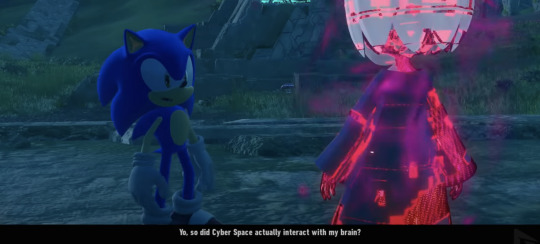

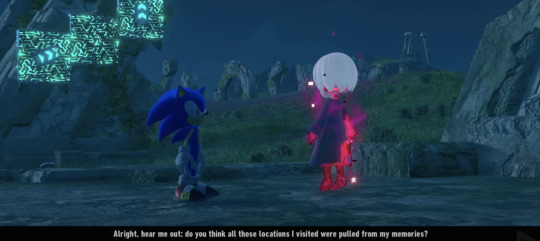

Sonic: “Yo, so did Cyber Space actually interact with my brain?” Sage: “It was designed to catalogue neural networks, among other things, so yes.” Sonic: “Alright, hear me out: do you think all those locations I visited were pulled from my memories?” Sage: “That is plausible. It imported the data of your memories and applied it to your surroundings so you could comprehend them.” Granted, Sage is technically speaking hypothetically herself, but knowing how Sonic lore works, we have to take this as canon information. Taking this at face value, we have to assume the cyber space we visit as Sonic is pulled from his brain.
Which is why it’s strange that at the end of the game, or DURING the game, Big is never technically mentioned outside of his fishing spaces. It would also explain why things like ring boxes

or springs

appear in the virtual lake at all. These are from Sonic’s memories!
You could also argue that being the reason why some of the things you catch look... well...

... strange, to say the least. (Sega’s turning the frogs gay, huh?)
If this is still all in Sonic’s perception, it’d also make sense as to why the blue-ringed octopus or the anglerfish look radically bigger than their real-world counterparts.


Could it just be that Sega didn’t do their aquatic homework? Like they didn’t do their basic research on hedgehogs or on geology/astronomy? I refuse to believe that completely preposterous outlook. Sonic saw a picture of an anglerfish and an octopus, and just like ME at AGE 5, assumed they must be the roughly the size of a bear. (Side note, I’m aware that some anglerfish can grow up to 3 feet, and Sonic’s 3 feet, but this is still an absurd size comparison).
That said, there are still things like the Hermit scrolls that occasionally show up, and Big literally sells you Eggman’s diary memos. One could argue, those things literally couldn’t be in Sonic’s memories. However, cyber space is a communal space. Apparently you can find out information from just about anyone in there.
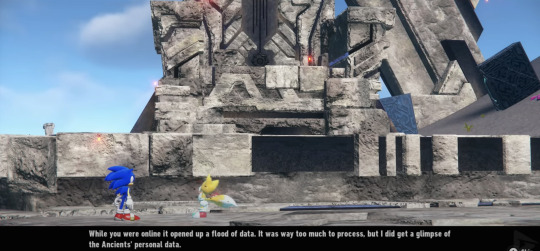
Tails: “While you were online it opened up a flood of data. It was way too much to process, but I did get a glimpse of the Ancients’ personal data.”
Based on this evidence, we can turn to Big, and question his role in Frontiers. He’s a merchant, he’s kind of a punchline, and he provides a break from typical gameplay (also a way to skip obnoxious memory token grinding sessions).
There’s... no reason for him to NOT leave cyber space. His presence in each fishing spot doesn’t suggest he is benefitting from his stay, nor is it assumed that he enjoys his time there. So why doesn’t he leave with them? Big simply tells Sonic that he was looking for fishing spots and ended up in cyber space. However, cyber space recreates itself for Sonic so that he could comprehend it. The Big we spend time with is very likely to be Sonic’s idea of Big, his memory of Big, or cyber space’s excuse to grant Sonic data. It could even be The End/spooky sky voice’s way of forcing Sonic to progress, disguising itself as Big, however my only evidence for that claim is during Sonic’s corruption, Big is not seen anywhere trying to assist Sonic. Even Eggman was there, not helping, but present.


Other than that, that theory is a stretch, even by my standards.
In any case, it was odd to me that Big was totally ignored throughout the game. He’s by no means the most popular character, but if we are to assume it IS the real Big, why would they leave him in cyber space? Why wouldn’t Sonic attempt to free him as well, or at the very least talk about him with other characters?
It may seem like Big is just a wacky character, who just happened to be at the wrong place at the wrong time as usual. But if that was all there is to it, why is this such a... Big... Mystery? Thank you for reading out my entire existential crisis. Please have a wonderful rest of your day. Play Frontiers, it’s fun.
#sonic frontiers#big the cat#sonic frontiers spoilers#theory#don't spoil the comic I haven't been able to read it#yet#if anyone has evidence disproving this theory I'm all ears! I'd love to discuss Sonic with people#even if it's a weird topic to have a conversation over#Again if the comic explains it in depth I haven't read it and I will eventually#It really was keeping me awake at night#this idea that the big we were talking to isnt real#sonic the hedgehog#miles tails prower#amy rose#knuckles the echidna#eggman#analysis#a game theory#rant#long post#sage the ai#prologue
85 notes
·
View notes
Note
poking you because I wanna be friends but dont know how to start a conversation /silly positive
- 🫶🏼
Friendship you say !! I would love that :Dc
I myself suck at initiating conversations, BUT I think a good place would to be find something we have in common,,,,, I don't know if I ever put my interests up publicly? I'll do so for you anon, since it may give us something to talk about <2
The Crew and Co. Collective Interests
Horror Media, but ESPECIALLY internet horror... so like, analog horror, digital horror, found footage, the likes. We do have some favorites tho!! and those are : Lacey's Games, The Mandela Catalogue, Vita Carnis, Daisy Brown, Everymanhybrid, Marble Hornets, Literally ANYTHING made by VibingLeaf on youtube, The Backrooms by Kane Pixel, and more that im probably forgetting
Drawing / Painting, both digital and traditional. We are character artists, and primarily character designers. So thats to say we suck at composition and backgrounds /silly/
Graphic Design. A good few of us toy around with designing logos, and flags, and userboxes- We love making pretty looking stuff because we cant work in a space that isn't aesthetically pleasing [shout out to on our our obsessive-compulsive disorders].
Writing / Poetry. I'm getting fired up at the thought of talking about my fantasy series, but I will sustain my control- We're HUUUUGE into writing, especially our own original stories, though we wish we had enough fandoms to write fics for. We tend to be a bit more goofy in our writing, and mature, but we've been told we have a decent writers voice for our characters which EEEEE when i was told that it was the biggest compliment ever,...
Speaking of fandoms!! We are in... literally none :( We don't know how to engage in fandoms anymore, or how to get attached to media, but in terms of fandom media, we like Steven Universe, KinitoPet, Minecraft [no mcyt's tho tbh], Stardew Valley, and Marble Hornets. I'm sure there is more, but I really don't interact in fandoms asides reposting fanart. We wish we could get attached to media like we did in our youth, but its an overall attachment issue :( We've lately been looking back into MLP stuff, but we can't draw ponies [we have pony ocs tho!]
Witchcraft / Paganism. We're a Solitary Witch with a 'specialization' in Candle Magick and Sigils.
Singing and Playing Instruments. Formerly, we were a Flute Player, but now we mostly play out 3rd baby, our Bass Guitar. We're very much music fans, and our musical roots on one side of my family goes back to, like, 1482 [thank you grandma for the genealogy folder on that one]. We mentioned it somewhere, but we have perfect pitch [as a result from all the music in our bloodline] and all we use it for is pitch matching tech. When we play our bass, thats how we do song covers tho! Because we can't read bass clef,,,, only treble.
Organizing Information and Data. Admittedly, this is more one specific cohost, but he's honestly gotten us all to like it to a certain extent.
Animation, stop motion and digital- We used to do traditional too, but it's wicked hard.
Crafting, but especially beaded bracelets and clay sculptures
Finally, our own ocverse. We have a hard time talking about it over tumblr dms because its so uncomfortable to message on [too used to discord], but you can literally get us going for hours, at least,,, if you heed the TWs of it, since our OCverse is rooted in our trauma.
and more...
If any are similar, or you just want to ask, feel free! Over anon or otherwise! I will also note that we love finding new media! We're terrible at it because we have bad anxiety when watching new media. But if youre willing to send it, I can try !!
1 note
·
View note
Text



this is nowhere near the total number of beetles i've identified over the past couple months but it is at least a decent majority of specifically the cerambycid beetles i worked on in that period, all of which i finally put proper ID labels on today in an insomnia-induced 12 hour mini-manic episode. not shown are at least several hundred more that i previously finished curating and put away. some ento rambling below the cut.
i've been bouncing between the three major woodboring beetle families, Cerambycidae, Buprestidae, and Scolytidae (do not correct me about them being a subfamily now i will literally never learn or change my ideas about them), and altogether have probably identified at least several thousand specimens to easily over a hundred species since i started my project to work through the insane backlog of donated/abandoned specimens in my lab and move them into our collection proper. i kind of regret not keeping track of the total number of specimens and species i've gone through but whatever. it's a lot and i'm proud of myself.
of the three families i'd say the 'bycids are overall the easiest, though there are some extremely obnoxious genera to key to species, and a few groups that are pretty much impossible, like the series of Methia specimens from southern california that not even larry bezark the extremely friendly keeper of the new world cerambycid catalogue was willing to help me with. they were silly as hell though


scolytids, bark beetles, seem like should be the hardest group to identify on account of being by far the smallest on average. for example here's a few different BBs compared to a pinhead:

BUT i have a very good work microscope and the species keys are generally well-written and thorough and more or less modern, whereas the goddamn buprestids are a complete fucking nightmare. in part because A) while there's far fewer genera in the bup family than the other two, at least in north america, a few of those genera have a fucking ABSURD number of species in them, primarily Agrilus, Chrysobothris, and Acmaeodera



all of which have over a hundred north american species often with highly-overlapping and variable appearances, sometimes literally only reliably differentiated by the morphology of their dongs and/or knowing the species of tree they came out of and god help you if you have a female or your specimen came from a flight trap without recorded biome data, and B) the keys to those species were all written literally over a century ago and are, frankly, kinda shitty! and severely out of date! surprise! that said i have still been plowing through hundreds of Agrilus and Chrysobothris specimens and with the exception of some particularly nasty species groups i've gotten decent-ish at IDing them. you literally could not pay me enough to fuck with Acmaeodera though. fuck those guys. hairy little polkadot bitches.
anyway i didn't really have a point to all that. as a reward for reading my insomniac rambling here's a bonus Bup, Bycid, and BB:




love my job
#technically it's an ambrosia beetle not a bark beetle but who cares its the same family#taxonomy is man's pathetic attempt at ordering the inherent and immutable chaos of the natural world#anyway time for my taxonomic tags#scolytidae#buprestidae#cerambycidae
215 notes
·
View notes
Text
magnus fic roundup
as tma comes to a close, i thought i'd post some of my favorite fics to come out of this fandom. most of these are classics, listed in no particular order.
A Weather In The Flesh by @cuttoothed | 3K | S1-S4 | Jon/Martin | Complete
"There is a span of years where Jon doesn’t touch anyone other than the occasional hand shake. It’s not so bad. He’s never been someone who’s needed physical affection."
Jon has never been any good at making people want to stick around.
↳ this is such a well-done exploration of jon’s character and his relationship with touch, and i’ve re-read it at least five times. sweet and sad and phenomenally well-written.
in the chillest land and on the strangest sea by imperfectcircle, singlecrow | 20K | Safehouse, S1-S4 | Jon & Daisy, Jon/Martin | Complete
Jon remembers a statement he read years ago given by a Jesuit priest, who said that the shortest prayer he knew was, just, fuck it, as in fuck it; it's in God's hands. He takes Daisy's hand and trails on after her.
or; hope is a thing with feathers.
↳ hey, you wanna fuckin..... feel things? read this.
The Magnus Institute vs the 21st Century: a series of emails and IMs by shinyopals | 26K | Series | S3 | Pre-Jon/Martin | Complete
The Magnus Institute hires a Data Protection Officer. He sets about diligently booking in meetings, writing policy documents, and training all the staff in the importance of confidentiality. Now if only he could get hold of the Head Archivist, who seems to have vanished again...
(Jon is only trying to save the world, but apparently some people think he should still be doing his day job.)
↳ i’d be surprised to find people who haven’t read this series, but it’s the definition of “the magnus archives is a workplace comedy”. also, alasdair stuart has actually read some clips of this on Twitch, so that’s a fun bonus.
Bell, Book, and Candle by yellow_caballero | 102K | Series | S3 into S4 | Jon/Martin | Complete
In accordance with the Ride or Die Pact of 2009, Jonathan Sims can call upon Georgie Barker at any time for aid with no strings attached. Despite their rocky history, their childhood friendship, and Jon’s barely recovered alcoholism, this pact is sacred and must be upheld.
Georgie Barker may regret this. She may regret it when she discovers that the world is full of monsters and eldritch gods and dickhead managers. She may regret it when a punk rocker who should be dead collapses on their doorstep, a teenager again who needs their help. She may regret it when her stupid ex-boyfriend starts selling his soul for knowledge and the ability to keep his new family safe.
But she probably won’t. Georgie isn’t scared of anything - not a Clown’s apocalypse, not the apocalypse that Jon is destined to begin, and not Jon’s own loss of humanity.
Maybe she should be.
↳ if you’re looking for an everyone-lives-no-one-dies-happy-ending fic that also happens to be massively chaotic, look no further.
The Reverb in These Holy Halls by @wolftraps | 98K | AU, S1-S4 | Jon/Martin | Complete
Undoing the apocalypse would have been enough for Jon, if all his people survived. Without them, Jon's only recourse is making it so it never happened in the first place. He's going to do better this time.
↳ quintessential time travel AUs. plot-wise, i feel like these can be difficult to write, but op does a fantastic job of tying things together in a way that makes sense. plus, it’s just fun to read.
jon sims v the nhs by @thoughtsbubble | 12K | Series | S3 | Complete
Joan Bright has a new patient. He's carrying an old tape recorder and is covered head to toe in scars. Jonathan Sims looks dangerous, but Dr Bright has dealt with all sorts of atypical individuals. She has no reason to be nervous.
Right?
↳ if you’ve ever thought “hey, jon should probably go to therapy”, then 1) you’re absolutely right and 2) this is... probably what would’ve happened. prior knowledge of The Bright Sessions is not required. also, apparently, this fic is written by the showrunner of The Underwood Collection? wild.
Family, Found by Dribbledscribbles | 9K | S4 | Complete
It’s Basira who catches onto it.
The collective shift that seems to come over them when heading in or out of the Institute. Not just the oppressive sensation of being observed, their every move catalogued for the voyeuristic cravings of some unseen Eye(s). That feeling remained with them even when they left the Institute these days, but it was always stronger inside its walls. That wasn’t the change. Nor was it the point.
The point was: making life worse for Jonathan Sims.
↳ i think being part of the avengers fandom circa 2012 has given me permanent found-family-trope brainrot, but you know what. jonathan sims can have a little happiness, as a treat.
Road to Damascus by @titanfalling | 107K | Series | S4 | Jon & Tim | Complete
n. an important moment of insight, typically one that leads to a dramatic transformation of attitude or belief
Or, in which Tim becomes an avatar for the end of all things.
↳ tim dies and then he doesn’t. there is catharsis and world building. just....read it.
Come, Change Your Ring With Me by @backofthebookshelf | 29K | S3 | Peter/Jon, Jon/Martin, Peter/Elias | Complete
The Lukases demand the Archivist marry into the family, and the Institute relies on them too much to say no. Peter is smug. Elias is fuming. Martin is suffering. Jon thinks this might be tolerable if only Peter would hurry up and leave him alone already.
OR, the soap opera we call an Archives revolves around Peter Lukas this time.
↳ superb evil-bastards-in-love content, feat. martin pining, tim being obnoxious, and jon being... well, tired, mostly. i will literally never get tired of how op writes peter.
creatures that i briefly move along by @dotsayers | 16K | Series | AU, Post-S4 | background Jon/Martin
Mr Sims was so weird, was the thing. Miss Grant always said calling people weird was rude, and Anna sort of agreed, but she didn’t know what other word to use to describe Mr Sims.
He’d only been in with the class for a few days, really, and half of that he just sat at the back listening, but that didn’t stop her from making a swift judgement. 5BG had had student teachers before, back when they were 3ST, and they’d been uniformly normal.
Mr Sims was… actually, Anna had a better adjective. He was interesting.
↳ i just.... love teacher!jon fics. this series delivers.
Once Bitten by @apatheticbutterflies | 1K | S4 | Jon & Daisy | Complete
Jon Sims has always been a jumpy kind of guy. Nervous. Twitchy. Daisy used to think it meant he was guilty. Turns out he was. Just not of what she’d thought.
Daisy learns how to peel an orange.
↳ daisy and jon’s relationship is an example of an instance where i’m happy to say “fuck what you wrote mr. jonny ‘chocolate torte of tragedy’ sims, i want them to be friends”.
pins and needles by mutterandmumble | 13K | S1-S4 | Complete
He’s got a reputation to uphold anyways; an uptight, rigid reputation that dictates the way that he interacts and functions and is such an integral part of him that he can’t let go of it anytime soon. He likes his safety nets. He likes his contingencies. He likes his privacy, and everything around this place right down to the walls seems to have ears, so he’ll stay tight-lipped up to and beyond the threat of death.
He’s good at that.
In which Jon takes up embroidery and bumbles through life the best that he can.
↳ out of all the introspective jon pieces i’ve read (and there are many), this one stands out. maybe it’s the symbolism or the characterisation, or maybe it’s the fact that i have an embroidery kit lurking in the back of my closet along with a hundred other half-pursued hyperfixations. whatever. this is excellent.
sleeping in by @ivelostmyspectacles | 5K | S2 | Jon/Tim | Complete
“Who are you trying to convince?”
Jon gives up, letting his head sag against Tim’s shoulder. “I don’t know.”
aka Elias gets tired of Jon and Tim's bickering, sends them away for a "team-building" weekend trip, and is sure to book them a room with only one bed
↳ this has everything you’d need from a “oh no there’s only one bed” fic. someone please get these men therapy.
if you try, sometimes (you get what you knead) by @ajcrawly | 3.5K | S1-S4 | Jon/Martin, Tim/Sasha | Complete
It starts with an abundance of boeuf bourguignon and ends up as a team tradition.
Food and love in uncertain times.
↳ more found family fic, this time with a diverse og!archival staff and food as a metaphor for love. hurt in all the right ways. made me hungry in the process.
#tried to keep this shortish but i might just make a part 2#people in this fandom are crazy talented#tma#the magnus archives#tma fic recs#fic recs#long post#txt#mine
223 notes
·
View notes
Text
@phdfan :
I'm curious about how you're approaching Obsidian (if you're still finding it useful that is). I've been reading about various strategies, and some people employ a kind of inbox for it where they dump undeveloped ideas initially... which I can see the use of, but fear that it will turn into yet another idea graveyard. How are you approaching it?
At the moment, I am using Obsidian a few different ways. My general purpose Work vault is structured differently from my special purpose vaults and, so far, only my general purpose vault has enough content inside of it to feel like it has a coherent, emerging structure, shape, and workflow.
A heavily modified and modernized zettelkasten approach is currently just a fraction of the notes and the structure, although I suspect over time that quite many zettlekasten notes will be managed by this system.
First, what i am NOT doing.
- I am not using arbitrary numbers (or a date-time stamp) to title my zettelkasten notes. That makes no sense in a digital system. I use human readable titles that are meaningful at a glance as a summary of the note.
- I am not relying only on associative links in a pure zettelkasten manner.
- I am not keeping my vault “pure” in that it is only zettelkasten notes
What I am doing is a little difficult to explain because I am using the power of digital archiving to overlapping multiple entry points into information by combining top down librarianship with cross-cutting sideways-slicing associative indices with project-specific groupings with bottom-up discovery through freeform tagging and crafted boolean+regex searches.
First, I have an anti-Zettelkasten feature --> I literally created a top-down library system for my information and I am currently using three digital numbers (ranging from 000 to 999) to create top down structure -- literally library stacks -- for everything that goes into my system. To help keep this sensible at a glance, I have special Library Catalogue note pages that index (catalogue) everything in that section. So, I have one catalogue note named 500_Mathematics_and_CompSci. It has links to other catalogue notes that are in the 500-599 range (and yes, numbers can be reused as long as the rest of the title is different).
For instance, one of the notes linked from that 500_Maths&CS note is 580_Artificial_Intellence_and_Machine_Learning. That note contains a wide variety of links, ranging from hyperlinks to resources on the web (with annotations, links to down to other more specific notes that either branch the catalogue further or are top-level entry points into my actual zettelkasten notes (I’ll describe those below), or to quick notes to myself that don’t deserve their own special note, or whatever else I just want to toss on that page. And all of this can be tagged. I can write a goal or a question or due date or a leave something half finished, and add a #00_goal or #00_question or #00_due_2020_Dec and find it later via search or the tags pane.
The point of this anti-ZK librarianship is that when I JUST WANT TO SEE only what is in the “Art and Art History” section of my “library” or only what is in the “Literature and Media” section and I just want to walk through it, like a library, I can do this and I don’t have to worry about statistics or mathematics or anthropology or qualitative methods or any other unwanted noise getting in the way. I can see what is there and just ... work with it. Birds eye view. Or drill down to find that one thing that I know is in there but I can’t think of the name so I can’t search. Or just for easy navigation right to the index, high level note, project, goal, image, file, data, or resource (internal or external) that I need.
It also allows me to create easy-to-find master pages of links to projects in the making or to some topic I am learning and to all of the resources I have collected that i need to go through.
...next...
From the bottom-up side of things, my zettelkasten notes are only written when I have something to say. Until then, those ideas float elsewhere in the system (I’ll get to that later on). When I have something to say that is original, that synthesizes two or more ideas, and is worth archiving.
All zettelkasten notes are named Z[code]_SomethingMeaninglAsTheTitle.
The codes have to do with the kind of Z note I have created. So far I have codes for:
- Z notes that propose overarching questions (hypotheses, research questions, artistic questions, project questions). These notes can cross reference other question cards or any other kind of card listed below. At some point these question may get duplicated and recoded as the next kind of Z card - a project card.
- Z notes that propose a specific project or thesis. A project can be anything that results in the production of some tangible thing. A thesis can be the main point of a project. These notes act as indices and entry points for other notes (below).
- Z notes that synthesizes a specific point from the literature or from other stuff/artifacts/media not created by me. In academia, these would be useful for writing the background and lit review section of a journal article. Outside of academia, their use is far broader, but same idea. These may cross reference other related cards in the “see also” section.
- Z notes that synthesize a finding or a design that is my own. I don’t have any of these cards in my system but if I imagine using this system 10 year ago I would probably have card(s) that explain categories or classifications from study data, or cards that detail the design of some system, etc. In the academic world, these would be referred to when writing up the results section of a journal article. Beyond academia, again, broader use.
- Z notes that synthesize big ideas that are my own or in my words or that make my big point. These would reference the cards categories above, obviously. In the aca world, these ideas end up in the discussion section of a journal article or they become the basis of some ballsy theory article. Outside of academia, these are entry points for a wide range of things.
...next...
I have ZR_ notes -- review notes. Always ZR_TitleOfThingReviewed.
These are book review, article review, media/lit/art review, and any other kind of note where I am summarizing someone else’s THING be it an artifact or a lecture/talk (lecture notes) or whatever. Everything that needs to be captured just goes into the note. The note is as long as it needs to be. That top-down library system describe up above? These reviews and notes get filled in as many sections of the library as necessary. Obviously, I can also find them through the search tool. And they get tagged for any project I might need them for. This allows multiple entry points to find them again.
...next...
When I am in the process of writing a ZR_[title] review note, I stick it in a special folder in my obsidian vault. These are unfinished or in-processing reviews. This also allows me to remember what I need to finish so I don’t take on more and I don’t let too much end up in here in the processing state.
While I have that review in processing, I use it to generate Z notes (as described above). When I feel I am done with the act of REVIEWING a THING, i finish up the act of processing (making more notes) and then I move that review note into the library [000-900] and “shelve” it in the main location it belongs and catalogue it in the appropriate library catalogue note, but I also use “see also” sections on those library catalogue pages so I can catalogue the review in multiple sections of the library.
...next...
I have a folder of personal goals notes and projects entry point notes. These notes are similar to the library catalogue notes and start with a letter+plus number code, where the three digital number corresponds to my library categories. Each contains internal and external links to resources, notes, etc., plus planning, mile posts, meta ideas, due dates, to do lists, and whatever I might need. It just all goes in. If multiple notes are needed for one project or one goal, so be it. The code in the start of the title keeps them filed together automatically.
I also create Queue notes inside these personal goals and projects note-clusters. Queues are what I need to do. What resources I need to review. What I need to think about. What I need to implement/make/experiment with/etc.
Process notes and whatever else a project needs gets filed in here if it isn’t something that makes sense inside of any of the other kinds of notes listed in categories described above.
...and finally...
“THE INBOX” folder and its notes- When I am capturing rando notes that fall out of the air, I just toss them all on one of a few special notes that are vaguely topic specific and act as an inbox that is already a bit categorical or a bit project oriented or a bit goal driven. I make a point of noting the reference if a reference/citation is involved so I can go back later and Review it (using process described above).
I process the inbox as time allows or when the mood strikes or when I feel bored with what I was doing or just need a quick brain break from what I am doing.
Sometimes I just read and reread those inbox notes until a better idea strikes.
As soon as some idea gets processed and turned into a real note (or becomes the beginning of a REVIEW or becomes a goal or project, I delete those lines/words from the inbox note they are in.
I try to keep an organic balance of these notes -- these jumbled captures of ideas that fall from the air -- such that none of the inbox notes gets too long (no more than a screen of text of a jumble of related ideas) but so I don’t have too many categories of inbox notes going at the same time either.
Can’t explain this any better. It is very organic. But, the reason why it isn’t one new idea per note is that ideas tend to repeat themselves so I want them clustered together. Easier to see that I’ve already had the same thought two days ago and it just needs a few more words.
...other...
I also have a few top-level to do lists and cheat sheets plus ever evolving templates for making certain kinds of notes that always follow the same format.
.
.
Obsidian vaults for specific projects look very different. As I make more progress with a vault that is specifically for capturing and structuring a complex work of fiction, I’ll describe what that looks like. Right now, those two vaults just aren’t large enough to be worth proper description of workflow or organization. Still evolving into something!
7 notes
·
View notes
Text
instagram
🤷
0 notes
Note
what if i ask u to make up some echoes from the future :/ like 3 :/

these are literally right off the top of my head there’s been absolutely no development you’re welcome.
one of the first generation born on one of the first human colonies after people start moving away from earth; becomes a leader of the community and very interested in travelling to other colonies ( but can never quite take herself away from her responsibilities ).
a computer genius who develops human time travel around the 24th century so it becomes more accurate and less of a random punt across the time vortex. some of her findings end up being used in the development of vortex manipulators.
an space traveller around the 50th century who’s essentially collecting data and cataloguing other worlds and exploring the human spread and its interaction with other species; mostly lives on a spaceship, and gives lectures on her findings at schools & universities when she’s landed somewhere for a while.
#ooc.#headcanon.#i guess idk?#withbox#inbox.#most of them are prob called oswin bc......it's a cool name but it doesn't rly work historically
2 notes
·
View notes
Text
Pixelmator Photo for iPad
This will take awhile to get to the point so if you’re interested, buckle in for a winding, drawn out reason about why I’m not switching to Pixelmator Photo as much as I want to.
I’m an avid Lightroom CC user. I have never used Photoshop, not because I don’t want to but because I’m too stupid.
In the past I was an Aperture user and it never clicked. The catalogue was too confusing to me. Again, stupid. When it was discontinued I switched to Lightroom and have done well with it since. Adobe later released Lightroom Mobile (now the cross-platform Lightroom CC) during the time I had adopted a heavy iPhone/iPad travel workflow and I grew up with the program. Lightroom was straightforward and essentially offers the simple tools that I used in the darkroom- dodging and burning, with digital exposure and color edits. Plus a little more.
I have had a strange fascination with Pixelmator for years. Many times since 2012 I’ve tried to use Pixelmator which is a layers based graphics editor. The price was right and they were an Apple only product that worked to make the most of the Apple hardware. They even released a mobile app with some of the core features. But again it’s a layers based editor and if I couldn’t figure out Photoshop this wasn’t going to help me. I looked often for tutorials to learn the software but they weren’t available like they are for Adobe products.
When Pixelmator Pro for the Mac was being released last year I was fully ready to make an attempt at using it and abandoning Lightroom.
Why would I leave Adobe? I don’t like that I’m boxed into one system. I pay 20 dollars a month for the photography Creative Cloud account with 2 TB of data. I have to be very careful with that catalogue as I go because 2TB isn’t a lot for a full and active catalogue over years, even with mindful archiving. And I’m managing two different photography catalogues- Lightroom and Apple Photos. Finally, the way you import photographs into Lightroom on the iPad or iPhone is plain silly, but that’s really on Apple and we’re not going to get into file management on iOS because that’s a dead horse for now (until some future iOS iteration).
But the big reason was: “minimalism”.
Over 2018 I started doing a deep dive into my life again. A significant breakup, several moves, and a job change made me evaluate everything. I adopted minimalism around 2009 when I started paring down my belongings and moved into a small loft apartment. When I moved to Rhode Island in 2011 I sold almost everything I owned then put an add on Craigslist to come get the rest for free and people swooped in en masse. I kept things lightweight as possible but things creep back in. My digital files were a mess. Papers kept following me around the country. When I lived on the Rez it was like Little House On The Prairie and I bought enough supplies and things to fix anything and felt I needed a lot of comforts. “Things” piled up. Tools, paint, gardening tools, furniture, home gym equipment, entertainment. By late 2016 I was maintaining 3 addresses over 3 states with homes and ‘stuff’ in all of them, a lot of it duplicated. Then I had to pack up all of the places and put them into storage and nothing makes you realize how crazy your life is than rampant disorganization, poor sleep, and putting your hands on every single thing you own. I literally started having recurring dreams about boxes of papers.
While I was traveling I couldn’t manage my physical things but I could manage my finances and digital assets. I was shocked by how many apps and pieces of software I owned or had a subscription to. I made the spreadsheet that showed monthly recurring charges and a lot showed up and were pared down. And this drew my eye to the Adobe subscription. It has jumped up from 9.99 a month to 19.99. 240 dollars a year every year. I can afford it and I use it aggressively but did I need it at that price?
iOS has become my main platform for doing everything. The iPhone alone can do most things you need and when you need the luxury of a bigger screen go to an iPad. When I watch or read reviews of any iPad people talk about how it can’t replace a computer and it makes me nuts. What does anyone do on a computer besides browse the web, shop, message your friends, watch YouTube and Netflix, and check email, and write (in that order)? iOS is fine for 99.99 percent of people except working graphics and video professionals, engineers, architects, and medical professionals (because medical software is the worst on earth and just can’t function on anything except a 12 year old Windows PC). I find working on an iPad is far more efficient than working on a Mac both digitally and physically. The ergonomics of touch with a Smart Keyboard are just better than keyboard and mouse (there is a reason the keyboard is so short- it’s so you can reach the screen easily). I edit photos with a pencil. I manipulate windows and screens like Minority Report. When I want to read something my ‘computer’ turns into a book/magazine/comic book/magical future tablet. I believe that my next Mac upgrade will likely be the last traditional computer I ever buy.
That aside over when I evaluated my tools, a lot of software like Word and Ulysesss, Byword, Simplenote, Evernote and OneNote, were abandoned for free, excellent software that came with my devices. Notes and Pages took over drafting, writing, and note collection. iCloud Drive replaced Dropbox, Music replaced Spotify. It kept everything neat, my data and privacy were secure and organized in one place, and I took the time to master the software. Where I had limped along on Excel for decades, I buckled down and did the full Lynda.com Numbers course and for the first time spreadsheets stopped being mysterious things nerds used to optimize their lives and instead became easily accessible tools that helped me solved real problems. A lot of this was also pushed by many of the privacy concerns arising in digital ecosystems (Facebook, Google, apps sending data out that users are unaware of, etc.).
But besides managing my day to day life and writing what do I use my tech for?
Photography.
Could I get rid of all of these photo editing apps? I adore shooting and editing on my iPhone and I seriously considered selling all of my cameras and becoming an iPhone only photographer. But different working opportunities continue to present themselves and so I kept using ‘real’ cameras and instead focused on addressing the software. Snapseed left. It’s a terrific app but I can do everything in Snapseed with Lightroom, but better. And I don’t trust Google anyway. All of the other silly one off apps disappeared too. They were niche cases and often all I needed was to dig into Lightroom to figure out how to replace them. But could I replace Lightroom with free Apple software?
Aperture was discontinued by Apple in 2015 (and it was definitely not free). The people who fully embraced it loved it, probably in the way people love Final Cut Pro. It was a different beast than their consumer product iPhoto which most people were familiar with and used without issue, mostly for collecting their images but also for doing basic editing. Apple replaced iPhoto with Photos (minimalism) with the emphasis on the iCloud Photos library and cataloguing. But on MacOS they were sneaking some Aperture features in on later releases like curves. It seemed like they were beefing up the Photos app for greater things and these features seemed to be mirrored onto the iOS versions of the app. With the release of the iPad Pro and the Apple Pencil it seemed like any week Apple would release some brushes but they didn’t. Instead you were stuck with very basic global edits (and of course stupid filters) and didn’t even have access to the MacOS features like HSL.
But you could open photos in other apps. Like Pixelmator for iOS. And... it didn’t work. It was a garbage dream and ultimately nothing was able to replace the features I used all the time in Lightroom CC, specifically: editing metadata, the gradient and radial filters, and dehaze. Add to that geometric perspective correction and the fact that on the Mac Lightroom CC was adding in Photoshop/Lightroom Classic features like panoramic merge and more.
When Pixelmator announced they were releasing a photography (vs graphic design) focused app, and that it was for the iPad I was thrilled. I signed up for email updates and trolled the web periodically for information. When it arrived (at the phenomenal price of 4.99) I had already preordered it. I downloaded it and got to work straight away. I love that it uses either Photos or Files for the catalogue (easier to manage and takes out a step used in Lightroom). And that’s it for the good. It uses Machine Learning. They want you to know that. They’ve pushed the hardware in the iPad. I believe it. But their big focus is on automagic edits and cropping, filter presets, and global edits. Honestly I can get that from Photos.app.
There are no brushes, no focal dodging and burning, no radial or gradient filters. It’s 2019, the iPad has this amazing Pencil, and neither Apple nor Pixelmator are taking advantage of it. If I cannot dodge or burn specific areas of a photograph, I am doing worse than I was in the chemical darkroom in 1997.
Photos.app needs to also beef up for me to use Pixelmator, specifically adding brushes and filters and one or the other needs to add the ability to batch edit photos.
In addition they need to add an iPhone app because I often edit only on my phone.
We’ll see what Pixelmator adds in the future. I’m sure I’ll still be paying attention for some reason.
Originally, about 6 months ago, this article was going to be about how I was going to switch from the yearly subscription of Adobe to Pixelmator but every time I tried to move my workflow over with serious photography I stuck with Lightroom CC because the tools are so strong. Without those tools I’m not going to use another photo editor. And I know there are others like Affinity Photo. For some reason I’m not interested. I just had this weird obsession with Pixelmator.
So that leaves me with what this article is about. I started deleting the original version of Pixelmator off of my iOS devices and Mac because I just don’t use it. Pixelmator became the thing to remove. It became an exercise of giving up the goat and not worrying so much about digital minimalism as using a tool that works and I that lets me be an artist. When I’m working professionally I can’t imagine not using Lightroom. And I use Lightroom CC which is considered ‘light’ anyway (but that’s foolish and something I should address later if people want me to). They’ve also recently added the features I wanted like stitching panoramas so for me it’s feature complete. It’s just the duplication of catalogues, online space, and the monthly fee that drive me crazy.
I’ve been making attempts of various strength since 2012 to use versions of Pixelmator and I’m not sure why it has seemed so important to me. I don’t need to use an app that makes global edits to a photo when I need to brighten eyes or increase the contrast in select areas of landscapes. I just need to use Lightroom.
#iPad Pro#Photography#Pixelmator#lightroomcc#Travel Photography#Pixelmator Pro#Apple#Pixelmator Photo#iOS
1 note
·
View note
Text

During the 19th century, emerald green pigment was all the rage in fashion and home decor—despite the fact that it contains arsenic. Photograph By Rebecca Hale, National Geographic
Science: These Green Books Are Poisonous—And One May Be On A Shelf Near You
A toxic green pigment was once used to color everything from fake flowers to book covers. Now a museum conservator is working to track down the noxious volumes.
— By Justin Brower | April 28, 2022
Libraries and rare book collections often carry volumes that feature poisons on their pages, from famous murder mysteries to seminal works on toxicology and forensics. The poisons described in these books are merely words on a page, but some books scattered throughout the world are literally poisonous.
These toxic books, produced in the 19th century, are bound in vivid cloth colored with a notorious pigment known as emerald green that’s laced with arsenic. Many of them are going unnoticed on shelves and in collections. So Melissa Tedone, the lab head for library materials conservation at the Winterthur Museum, Garden & Library in Delaware, has launched an effort dubbed the Poison Book Project to locate and catalogue these noxious volumes.
To date, the team has uncovered 88 19th-century books containing emerald green. Seventy of them are covered with vivid green bookcloth, and the rest have the pigment incorporated onto paper labels or decorative features. Tedone even found an emerald green book on sale at a local bookstore, which she purchased.
While these poisonous books would likely cause only minor harm unless someone decided to devour a nearly 200-year-old tome, the alluringly vibrant books are not totally without risk. People who handle them frequently, such as librarians or researchers, may accidentally inhale or ingest particles that contain arsenic, which could make them feel lethargic and light-headed or suffer from diarrhea and stomach cramps. Against the skin, arsenic can cause irritations and lesions. Serious cases of arsenic poisoning can lead to heart failure, lung disease, neurological dysfunction, and—in extreme situations—death.
So just how common are these poison green books? “It's somewhat hard to predict because our data set is still small, but I would certainly expect there could be thousands of these books around the world,” Tedone says. “Any library that collects mid-19th-century cloth publishers' bindings is likely to have at least one or two.”

After bookcloth became a popular and affordable alternative to leather for bookmaking, publishers began releasing volumes in a range of colors, including emerald green. Photograph By Rebecca Hale, National Geographic
A Color To Die For
Emerald green, also known as Paris green, Vienna green, and Schweinfurt green, is the product of combining copper acetate with arsenic trioxide, producing copper acetoarsenite. The toxic pigment was commercially developed in 1814 by the Wilhelm Dye and White Lead Company in Schweinfurt, Germany. It was used everywhere, from clothing and wallpaper to fake flowers and paint. To say that Victorian England was bathed in emerald green is an understatement: By 1860 more than 700 tons of the pigment had been produced in the country alone.
Arsenic’s toxicity was known at the time, but the vibrant color was nevertheless popular and cheap to produce. Wallpapers shed toxic green dust that covered food and coated floors, and clothing colored with the pigment irritated the skin and poisoned the wearer. Despite the risks, emerald green was ingrained into Victorian life—a color to literally die for.
While toxic green goods flooded parts of Europe and the United States, another invention transformed the bookmaking industry. Early 19th-century books were handcrafted, leather-bound artisan creations, but the industrial revolution quickly provided a way to mass produce books for a growing population of readers.

Traditional clothing fabric can’t withstand the book binding process, and it isn’t sturdy enough to function as a cover. In the 1820s publisher William Pickering and bookbinder Archibald Leighton developed the first commercially viable process to coat fabric with starch, filling in the gaps of the weave and producing a sturdy material: the first bookcloth.
“It was a game changer,” Tedone says. “Cloth was so much less expensive than leather, which meant you could sell books at different price points.” The process affected more than just the publisher’s bottom line; it changed how books were read. “They were making books accessible to a much wider demographic, catering to people on all levels of the economic spectrum.”
Cloth-bound books took off in the 1840s, and the process of creating bookcloth became a closely guarded secret. “It meant a lot of money to publishers, so unfortunately, there’s not a lot of documentary evidence about bookcloth making,” Tedone says.
What we do know is that book covers could suddenly take on a wide range of hues. Bookmakers produced a colorful array of books with dyes, which are solutions that chemically bond to the substance they’re applied to, and pigments, which are materials that physically coat the substance, like dried mud on a Sunday dress. As such, the era’s most fashionable shade of green pigment could grace the covers of popular books.
The trouble with pigments, though, is that they tend to crack, peel, and flake off over time.
Poison In The Library
In the spring of 2019 Tedone received a request from a curatorial fellow at the Winterthur gallery to borrow a book from the library to put on display: Rustic Adornments for Homes and Taste, published in 1857.
“This particular book was very beautiful, bright green with lots of gold stamping. It was very visually stunning, but it was in really bad condition,” Tedone says. “The spine and the boards were falling off, and the sewing had broken, so it needed to be conserved before it could go on exhibit.”
With the beautiful yet broken book under the microscope, Tedone peered at the front board. “There was a black, waxy excretion on the surface, and I was trying to pick it off of the bookcloth with a porcupine quill,” she says. “And then I noticed the colorant in the bookcloth was flaking off really easily around the area where I was working.”
To the untrained eye, this might seem normal for a 162-year-old book, but to Tedone it was surprising. “It didn’t seem like the cloth was dyed,” she says. “It seemed to me that maybe the starch coating on the cloth was mixed with a pigment.”
To learn the identity of the mysterious green pigment, Tedone turned to Rosie Grayburn, head of the museum’s scientific research and analysis laboratory.
Grayburn first studied the sample with an x-ray fluorescence spectrometer, which bombards material with x-rays and measures the energies of emitted photons to determine its chemical composition. This technique can tell you the elements that are present, but not how they are arranged in a molecule. Another technique using a Raman spectrophotometer measures how light from a laser interacts with target molecules, shifting the energy of the laser up or down. Much like each person has unique fingerprints, every molecule has a characteristic Raman spectrum.
The sensitivity of these techniques is key, but equally important is that they are nondestructive. “You shouldn’t be damaging works of art,” Grayburn says.
X-ray fluorescence revealed the presence of both copper and arsenic in the green pigment, a key finding, and the unique fingerprint from Raman spectroscopy positively identified the pigment as the infamous emerald green.
Handling Poison Literature
The team next used the University of Delaware soil laboratory to measure the amount of arsenic in the cover of Rustic Adornments. They found that the bookcloth contained an average of 1.42 milligrams of arsenic per square centimeter. Without medical care, a lethal dose of arsenic for an adult is roughly 100 milligrams, the mass of several grains of rice.
“What are the implications of having so much arsenic in bookcloth, on your gloves, during treatment? What does that mean for your health and safety?” Grayburn asks.
To answer these question, Tedone and Grayburn reached out to Michael Gladle, the director of environmental health and safety at the University of Delaware. “Arsenic is a heavy metal and does have some toxicity associated with it, principally, either inhalation or ingestion,” he says. The relative risk of emerald green bookcloth “depends on frequency,” Gladle says, and is of primary concern “for those that are in the business of preservation.”
Gladle suggests that anyone handling these tomes should isolate the books and work on them on tabletops with fume hoods to control any arsenic particulates. “People that have access to these old books for research should be wearing gloves and using a designated space to review those books,” he says.
Following Gladle’s recommendations, Winterthur library removed nine green, arsenic-clothed books from circulation and placed them in large sealable polyethylene plastic bags. When handling or conserving afflicted books, they wear nitrile gloves, and afterward they wipe down hard surfaces and wash their hands.
The team then launched a search for more books, travelling 25 miles northeast to the oldest library in America, the Library Company of Philadelphia. There they identified an additional 28 emerald green cloth books. With a larger sample size, they discovered that most books with arsenic-containing emerald green bookcloth were published in the 1850s.
To help others identify the arsenic-clad books and their potential risks, the team designed full-color bookmarks with images of emerald green covers as well as handling and safety precautions. They’ve mailed over 900 of these bookmarks throughout the United States and to 18 other countries, resulting in six other institutions identifying arsenic-laced books in their collections.
Despite the toxicity of arsenic-based emerald green in household goods, wares, and clothing, it was never prohibited. Instead, its use died out naturally, either from its toxic reputation or the color simply falling out of fashion, much like the avocado green appliances in the 1970s.
And the most important message from Tedone, ever the conservator, is to not discard the poison books. “You don’t need to panic and throw them away,” she says. “We just want people to take it seriously.”
1 note
·
View note
Text
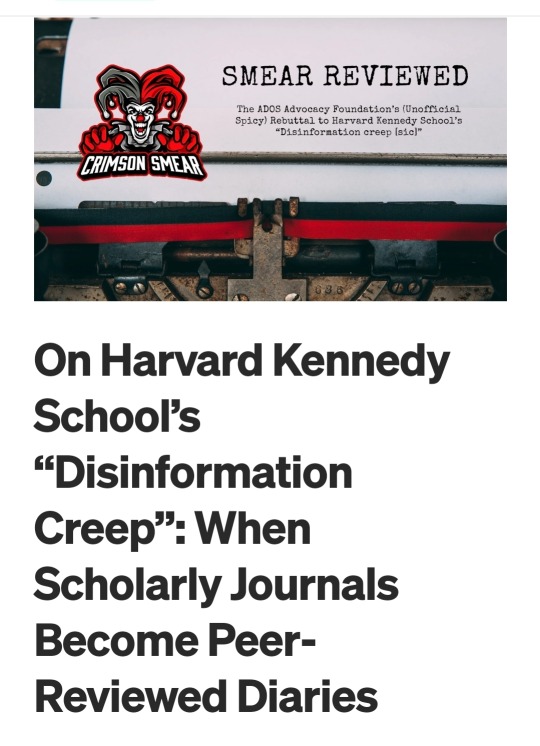
I’m not trying to hide my personal beliefs about these people in some pseudo high-minded analysis that purports to be about something else.
If, however, you’re looking for that sort of thing (that is, if you’re looking for an example of an actual hit piece!), you will surely find no greater example than the Harvard Kennedy School’s Disinformation creep: ADOS and the strategic weaponization of breaking news.
As far as hit pieces about the American Descendants of Slavery movement go, Disinformation creep is the one that really aspires to a kind of hang-that-sucker-up-on-the-refrigerator worthiness. It’s Harvard-certified, after all! And gosh, if there were ever an institutional badge with which all ten (ten!) authors of Disinformation creep could dazzle everyone in the rancid social-professional hierarchy they are all so obviously and desperately trying to climb, it’s certainly Harvard U.
But in fact the imprimatur of Harvard on Disinformation creep seems to serve exactly one function: to discourage the reader of the study from considering the fact that what he or she holds in their hands is utterly dishonest horseshit, a bizarre medley of unambiguous lies produced by people (again, ten people!) whose need to bathe in Harvard’s artificial validation seemingly trumped their felt responsibility to adhere to even the most basic and minimal set of ethics and standards in their chosen field of scholarly publishing.
I have literally no idea where to even begin in terms of communicating the enormity of Disinformation creep’s failure. Do you know the GIF where a cat tries to leap from a dresser to a bed and stalls out about midway and just sort of belly-flops onto the floor? That’s how Disinformation creep performs.
It is a monument to unsuccessfulness, and on every single one of its sixteen pages there is evidence of intellectual bankruptcy of the absolute highest order.
The forthcoming official rebuttal from the ADOS Advocacy Foundation does an excellent job at identifying each of these numerous lies and idiocies and countering them accordingly, but I think the report’s grand stupidity and essential hollowness can really be distilled to a single aspect of “Figure 1”.

The above graph from Disinformation creep provides a visual representation of the daily number of tweets “specifically using the #ADOS hashtag” over an 11-month period. These tweets are what the authors use to assert that there is an observable pattern of high Twitter activity within the ADOS ‘network’ around “real-world events” (e.g. MLK Day; Chadwick Boseman’s death; Kamala Harris announced as Biden’s VP pick, etc.), and that the content of the tweets on these days reveals how the “ADOS network strategically uses breaking news events to discourage Black voters from voting for the Democratic party.”
OK. Welp. By including screenshots of some of these tweets in the graph, the authors allow us to see for ourselves the kind of content they supposedly carefully analyzed in order to support their hypothesis. Notably, on August 2, the second largest spike in tweets using “#ADOS” is shown to have occurred. The authors identify a total of ~7,000 posts that day.
Incomprehensibly, the authors used a tweet about a cryptocurrency scam that translates to “‘The question is quickly answered’: many French #teens have dropped out of school, thinking to become [stock] #trader[s] in buying #formation kits. They fell into the trap of #Melius, based in #Dubai and known by other names. L’AMF and #Miviludes are seized.”
In French, “ados” means “teens”. And because the social media staffer at Mediavenir — when they were writing that tweet — slapped a hashtag in front of it, it eventually came to be swept up into Disinformation creep’s “dAtA sAmPLe sEt” despite having literally nothing what-so-fucking-ever to do with the actual #ADOS political movement which Harvard is asking the public to trust that they have specifically and diligently studied.
How does this happen? How does this glaringly and utterly irrelevant tweet manage to be not just included in the dataset but held up as somehow representative of the black-targeted misinformation content dump that the authors claim defines the ‘ADOS network’ on ‘high-activity days’? What about other tweets that include “#ADOS” and which similarly have absolutely no relation at all to the political movement, such as this one, or this one, or this one?
How many of those are part of the daily totals? I know the authors use a bunch of real fancy-sounding, applied science-y jargon in the report to describe their process (e.g .”computational grounded theory”; “structural topic modeling”; “inductive thematic analysis”), but like, despite these apparently sophisticated tools, there is still clearly a presence of laughably irrelevant tweets to be found among the collection of data.
Does it matter? Should it? Um, probably, yeah, if your intent is to not undermine your own work’s quality, to say nothing of your own dignity. More importantly, how did this get through a peer-review process? Who were the peers? Drooling invalids that were instructed to blink if they thought the study passed muster and was ready for publication? Some poor low-tier academic saps who were brought to a dingy basement somewhere in Kendall Square and made to strip down to their underwear while Harvard data experts stubbed out lit cigarettes all over their flesh and barked at them to sign off on Disinformation creep’s patently bunk methodology?
These sorts of scenarios rush in to try and explain the pure absurdity of the report, to fill in the vacuum occasioned by its vast gaping absence of basic evaluation standards in scholarly publishing, criteria that one might reasonably anticipate being insisted upon by an institution like Harvard which openly fancies itself as being like the sacred flame of academia or whatever.
Or maybe not.
Maybe you are actually not surprised at all. Maybe you know that since Disinformation creep aims to portray the #ADOS movement as irredeemably toxic simply because it represents the possibility of actual repair and freedom for the descendants of chattel slavery, Harvard would in fact happily become much more lenient and accommodating in their standards if it helps to kill the vehicle for that possibility.
After all, this is the same institution whose lawyers just successfully litigated the University’s retention of property rights to photographs of slaves following a lawsuit that was brought against Harvard by Tamara Lanier, a woman who — as a descendant of the father and daughter that are pictured — argued that she was the rightful owner of the images.
This is the same institution whose administrative staff just recently reminded the school’s highest-profile black faculty member that he could expect Harvard to extend him about as much freedom and protections in his work as a white landowner would have conferred upon his black sharecropper in the Mississippi delta in 1896.
This is Harvard, after all, and good old-fashioned racism is still very much alive and well in this vaunted cathedral of higher learning.
The hope is, I guess, that outward actions like the school’s appointment of a Chief Diversity and Inclusion Officer will distract you from the institution’s complete inward deformities of racial injustice that have defined both its past and present. The hope is, I guess, that Harvard can just kind of jot off one of its total bullshit-y pronouncements of ‘solidarity’ whenever the continued fever of American racism spikes, as if the institution itself has not always been right there helping stoke the fire to its full strength in the body of society. The hope is, I guess (and Disinformation creep proves this), that Harvard will never have to confront a real, organized threat to the fact that the institution pretends not to continue to fatten itself on the misery of ADOS.
But which is why — with the abysmal failure of Disinformation creep — Harvard should be very worried. The timing of such a cack-handed, deeply stupid effort by ten writers united in their ineptness to make ADOS an object of reactionary horror could not be worse for the institution.
Let’s deny the descendants of slaves rights to photographs of their ancestors! Let’s refuse tenure consideration to one of the premiere black intellectuals in America who’s spent his career advocating for black people! Let’s mobilize in dishonesty *against* the movement now trying to secure justice for that very collective!
What a hapless, blinkered, and desperately clumsy bunch of white supremacists over there in Cambridge, huh? Pointy-headed ninnies all cloistered away from every conceivable brutal reality of ADOS life and who all seemingly decided one day that it was their God-given right to root out the seeds of possibility that the #ADOS movement is planting in this country.
This is what the academics at Harvard are doing to help America’s bottom caste as the world around these people skids into the abyss. They are publishing their little ‘scholarly articles’ replete with lies so vulgar and obvious that it stands to reason the authors involved in the writing undertook the project with one single expectation: that they would be able to freely invent whatever filth they wanted to about ADOS and no one would question a word of it simply because the report came out of Harvard.
Indeed it is a direct testament to how much contempt and disdain Harvard has for the plight of ADOS that they would even consider publishing such an obvious clown car of researchers in the first place. Fully six of these goblins have no previously published content that has been accepted into the Web of Science (which, to be kind of crude about it, you can think of as sort of like the IMDb of academics; WoS catalogues the number of citations, and thus, provides the basic metric of impact/importance of research).
In other words, these writers have about as much authority and credibility in this space as a group of elementary school children who were all collected at a rural bus stop, given pencils and notepads and juice boxes and told to ‘write about those baddies in the #ADOS movement’.
Who are these people? Are they just bored? Unloved? And how are they so very bad at what they do?
They should wake up embarrassed.
They were tasked with not even creating but just building upon one already existing lie: that the #ADOS movement is essentially an online factory of misinformation (indeed, the original architectress of that lie is Jess Aiwuyor, and Disinformation creep reads very much like a sad, dull and weird extension of her own body of work, which is essentially one sad, dull and weird neurotic meditation on ADOS).
People paid the scummy little clan of Disinformation creep writers handsomely to gussy up that original lie a little bit — to give it a little slick veneer of scientific observation — and in the end these pedantic cretins who evidently think they are so much smarter than everyone else couldn’t produce a remotely convincing or even vaguely entertaining case.
But of course Disinformation creep failed. Of course it did. And that’s because, at the end of the day, there are only so many ways to dress up what these people are really doing when they write shit like this, which is that they are trying to make the #ADOS movement the scapegoat for the deficiency-ridden politics of the Left.
That’s it.
You can distill the entire genre of anti-#ADOS ‘criticism’ down to that single impulse — that tightly wound coil of emotion, of melancholy that lives at the heart of these people’s obsessive determination to get rid of the movement. For them, #ADOS functions purely as a scapegoat for their own failed postwar utopias and workers’ revolutions. And what Disinformation creep proves is just how completely exhausted the genre already is after a mere two years. How utterly lacking it is in its efficacy.
What it proves is that the harder they try to hurriedly scuttle the most potent justice movement since the Civil Rights era off the scene, the more they manage only to reveal a basic, repugnant truth about themselves: their determination to further dispossess the very people whose suffering and deprivation they all spill so much ink over, and waste so much breath claiming to be so very outraged and heartbroken about. Just look at Harvard.
All Harvard succeeded in doing was exposing itself. It confirmed what’s becoming blindingly apparent about so very many of our elite liberal institutions in 2021: that these privilege farms don’t function all that differently than they did in the plantation days. They just as nonchalantly enrich themselves off the wholesale spoliation of ADOS, and they’ve been able to feign innocence because of a movement-free, symbolism-intoxicated climate that not just permits but encourages such despicable action.
Well, Harvard, the #ADOS Advocacy Foundation has three words for you: We’re here now.
0 notes
Text
Toast Titanium Mac Keygen

Toast Titanium Mac Keygen Bandicam
Toast Titanium Mac Keygen Download
Nov 24, 2020 Roxio Toast Titanium, the leading DVD burner for Mac, makes burning even better, adding Roxio Secure Burn to protect your files on disc and USB in Mac- or Windows-compatible formats. Get more style with more than 20 themed templates with menus, submenus, and chapters in Toast MyDVD, the pro-quality disc authoring tool.
Toast 19 Titanium makes it easier than ever to burn, copy, capture, edit, convert, and share digital media. Toast 19 Titanium is a valuable collection of digital media apps for Mac, and includes Blu-ray Disc authoring, photo editing tools, and more!
Sample Results From Member Downloads
The application can also be called 'Toast 6 Titanium', 'Toast 9 Basic', 'Toast 6 Lite'. This application can be installed on Mac OS X 10.5.0 or later. The application belongs to System Tools. The most popular versions of the tool are 12.0, 11.2 and 10.0. This Mac download was scanned by our antivirus and was rated as malware free.
Download NameDate AddedSpeedToast Titanium 8 Mac13-Dec-20202,077 KB/s[NEW] Toast Titanium 8 Mac13-Dec-20202,668 KB/sToast Titanium 8 Mac KeyGen12-Dec-20202,007 KB/sToast Titanium 8 Mac Download08-Dec-20202,540 KB/sToast_Titanium_8_Mac_Updated_202008-Dec-20202,862 KB/sToast.Titanium.8.Mac_08.Dec.2020.rar08-Dec-20202,693 KB/sToast Titanium 8 Mac ISO02-Dec-20202,466 KB/s
Showing 7 download results of 7 for Toast Titanium 8 Mac
Toast Titanium 8 Mac Download Search Tips
To create more accurate search results for Toast Titanium 8 Mac try to exclude using commonly used keywords such as: crack, download, serial, keygen, torrent, warez, etc. Simplifying your search should return more download results. Many downloads like Toast Titanium 8 Mac may also include a crack, serial number, unlock code, cd key or keygen (key generator). If this is the case it is usually found in the full download archive itself.
Welcome To FileFixation.com
FileFixation.com is a new file sharing web service which gives you access to literally hundreds of thousands of direct downloads including software, games, movies, tv shows, mp3 albums, ebooks and more! Our downloads database is updated daily to provide the latest download releases on offer. To celebrate our launch we are offering unlimited full download access for FREE! This is a limited offer and will soon expire and revert back to the normal member price. We now have 431,315 downloads in the member section. Take the FileFixation tour now for more detailed information!
What is a Crack?
The word 'crack' in this context means the action of removing the copy protection from commercial software. A crack is a set of instructions or patch used to remove copy protection from a piece of software or to unlock features from a demo or time-limited trial. There are crack groups who work together in order to crack software, games, etc. If you search for Toast Titanium 8 Mac Crack, you will often see the word 'crack' amongst the results which means it is the full version of the product.
What is a Serial?
The word 'serial' means a unique number which identifies the license of the software as being valid. All retail software uses a serial number or key of some form. The installation often requires the user to enter a valid serial number to proceed. A serial can also be referred to as a 'CD Key'. When you search for Toast Titanium 8 Mac Serial for example, you may find the word 'serial' amongst the results. This usually means your software download includes a serial number of some sort.
What is a Keygen?
The word 'keygen' means a small program that can generate a cd key, activation number, license code, serial number, or registration number for a piece of software. KeyGen is a shortened word for Key Generator. A keygen is made available through crack groups free to download. When writing a keygen, the author will identify the algorithm used in creating a valid cd key. Once the algorithm is identified they can then incorporate this into the keygen. If you search a download site for Toast Titanium 8 Mac Keygen, this often means your download includes a keygen.
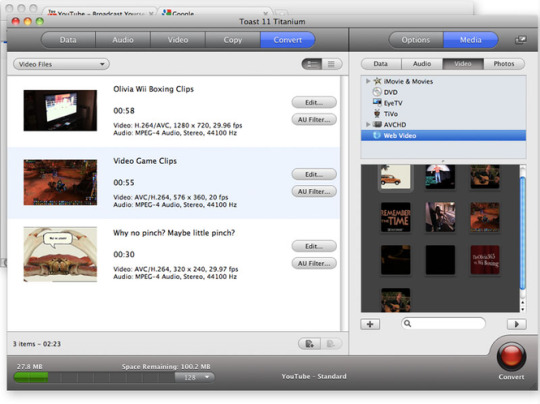
Popular Download Searches
Toast Titanium 8 Mac, Mulawin The Movie, Reigns Game Of Thrones Dinobytes, Ix1d V3.34, MP3 Rm Converter V1.00 By Orion, Bookmarx V2.00 Zip, Acronis True Image Echo Enterprise Server 9.7, Vreveal 1.3.3, Adobe Flash Builder Premium 4 0, Forge 9.0e, Buzzhost Net, Ontrack Easyrecovery Professional 6.10, Windows Xp Genuine Maker, Okiservis Net Clone, Resigo Pro, Spybuddy PC Surveillance 3 X, Fonepaw Mobile Transfer 1.8.0 Multilingual Portabl, Schlumberger Petrel, Super Screen Recorder 4.0,
[ Home | Signup | Take A Tour | FAQ | Testimonials | Support | Terms & Conditions | Legal & Content Removal ] Design and Layout © 2020 FileFixation. All rights reserved.
Roxio Toast Titanium 16.0.4745 Multilingual MacOSX | 679 MB
Information:
The leading digital media manager and DVD burner for Mac. The #1 digital media suite and DVD burner for Mac! New! MultiCam Capture – connect and record multiple devices to capture synced video, audio and your computer screen at the click of a button. New! A Fresh New Look – access all the tools you need in one place-burning is always at the heart of the application.
Complete DVD burner for Mac and digital media suite – New! MultiCam Capture video capture and screen recording software – New! A fresh modern user interface – Burn and copy CDs and DVDs – DVD authoring with menus and chapters – Encrypt discs and USBs – Capture and convert video and audio
Burn & Copy Toast is the easiest and fastest way to burn your digital media. It’s a DVD and CD burner for Mac and PC in one – complete with banking-level encryption. Burn music or data, or create DVD movies complete with titles, menus and chapters. Copy* discs or even recover files from damaged discs!
Capture & Edit Enjoy screen recording software or capture* video and audio from the internet, old tapes, LPs, camcorders and more. Record multiple devices simultaneously with new MultiCam Capture. Trim video or enhance audio with easy editing filters and tools.
Convert & Share Convert video or audio files to popular file formats and playback on your phone, tablet, video game consoles and other popular devices. When you’re ready to share your digital media, easily output it to your desired device, burn to disc or upload it directly to your YouTube, Facebook, or Vimeo account!
Toast Titanium 16 Features:
Advanced DVD authoring Turn your videos into professional-looking discs with Toast MyDVD. Burn to DVD with customizable menus and music. Get polished results with 20+ themed templates and easily combine multiple movies onto one disc.
Secure your data Burn data to disc or write encrypted data to a USB drive with Roxio Secure Burn. Secure your data with banking-level encryption (AES 256-bit) and password protection. You control the security settings, so you can be certain your data is secure on removable media.
Drag, drop, burn Toast is the easiest and fastest way to burn your music, video, photo and data files onto CD or DVD for both Mac and PC. Simply drag and drop to burn!
Toast Titanium Mac Keygen Bandicam
Audio disc spanning Span audio CD projects across multiple discs with Audio Disc Spanning-even customize your tracks and discs for the perfect music mix.
Maximum compatibility Secure your documents in Mac-only or Windows-only formats, or, create encrypted files that can be read on both Mac and Windows computers. Even burn HD videos on standard DVDs to playback on Blu-ray disc players.
Disc Backup of your data AVCHD Archive makes it one-step simple to backup an entire camera of HD video to disc and automatically keep a preview version on your Mac for easy browsing. Easily archive up to 50GB of data on high capacity Blu-ray Discs (no additional plugin required).
Easy search and retrieve Automatically catalog your discs as you burn with DiscCatalogMaker, then quickly browse the files and folders of your catalogued discs, and search by all or part of a file or folder name.
Every file at your fingertips Toast’s convenient Media Browser makes it quick to find the right content for your project. The Media Browser includes file browsing, Spotlight search, browsing iTunes, iPhoto, iMovie, Aperture and now Lightroom support.
Copy discs Easily create a copy* of your CDs, DVDs and Blu-ray Discs. Copy Mac OS, Toast, and other disc image formats-whatever the original disc is, Toast can copy it*. You may also copy discs to digital files to playback on your favorite devices.
File recovery for damaged discs Don’t risk losing vital data. Recover previously unreadable files from damaged discs and copy them onto a new disc along with a list of unrecoverable files so that you know at-a-glance what needs to be recreated.
Toast Titanium Mac Keygen Download
New! MultiCam Capture Plug in your cameras, press record and capture video and audio from multiple devices simultaneously. Stream all of your connected devices in one place and even adjust the camera’s image to calibrate the color and brightness of each camera feed. From software training to unboxing videos, capture completely synced video and audio from multiple devices that’s ready to edit at the click of a button.
Screen Recording Software Record system audio, voiceover and content directly from your screen with Live Screen Capture. It’s a fast and easy way to add interesting content to videos, presentations, and other projects, or to create tutorials or demonstrations to share. Select the monitor, window or outline the portion of the screen you want to capture and press record.
Capture streaming videos Save streaming web videos from your favorite sites-simply identify the video and capture it. Toast can even send it automatically to iTunes for syncing with your favorite device or it can burn to DVD for playback on your big-screen TV.
Capture audio Import audio from almost anywhere-LPs, tapes, microphone sound, or streaming Internet audio. Even rip audiobooks for playback on your favorite device. Clean up and enhance recordings with audio filters and capture music to iTunes automatically.
Extract & edit video clips Trim start and end points and remove unwanted segments in the middle of video clips before export. Extract video clips from your home DVDs and convert them to popular formats to play back on the device of your choice.
Crop and trim video Focus on the best parts of your videos and crop, trim or remove unwanted segments with the simple editing tools in Toast Slice. Save your clip as a file or send it to Toast MyDVD and add it to your DVD project.
Enhance audio with filters Clean up and enhance your audio tracks or voice recordings with Toast Audio Assistant audio filters. Remove noise and add your audio directly to your music library or easily burn it to CD.
Convert video Convert videos from the web or camcorder to popular formats compatible for playback on your favorite device. Includes support for DivX Plus HD, MKV and more. Export to video for Adobe Flash with an automatically generated HTML template.
Save time with custom video profiles & presets Quickly create or convert video to popular formats with a broad selection of video presets, making it easy to view your files on your favorite devices.
Schedule conversions Schedule video conversion projects to run when you’re away from the computer, even pause and resume conversions. Preview a short clip of your video at selected quality settings to ensure optimal video quality.
Upload directly online Post your photos or videos directly to YouTube, Facebook, or Vimeo in just one step to share with friends, family and the world. With one click Toast will even tweet your YouTube and Vimeo video links.
Share on both Mac and PC Choose a flexible DVD burner for Mac that enables you to create hybrid discs with content unique to the Mac or PC, including custom icons, background images, and discs that “autorun” on PCs. Easily create cross-platform photo discs for easy sharing.
HD video playback Playback high definition DVD-videos created with Toast on your Mac, PC, favorite device or on the big screen. Roxio Toast has everything you need to enjoy your digital media without limits-at home, on mobile and online.
Minimum System Requirements: – Mac computer with an Intel processor – 1 GB RAM recommended – Requires macOS X 10.10 and above – Approximately 1 GB of free space to install all components – VideoBoost requires a compatible NVIDIA card and 4GB of RAM for optimal performance – English, French, German, Italian, Spanish and Japanese
Home Page –

0 notes
